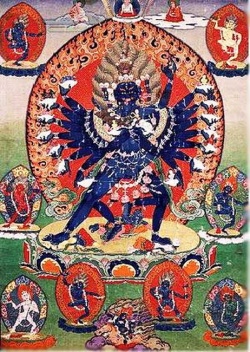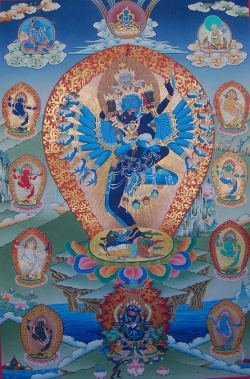Yidam Hevajra
<poem> The tradition of meditation on the yidam Hevajra (Tibetan Kyedorje or Gyepa Dorje) stems from the great king of Uddiyana, Indrabhuti. From him it was passed down through a chain of Indian Tantric practitioners including Mahapadmavajra, Anangavajra, and Saroruha, and found its way to Tibet in the eleventh century. The Hevajra Tantra, of which the yidam Hevajra is the personification and embodiment, is a tantra of the Mother class. It has been very influential on the whole field of Tantric practice. (It is in the system of Hevajra that the very important yoga known as tummo, the psychic heat yoga, first appears.)
The word he is a joyful exclamation, meaning something like 'oh!' Vajra, of course, is the diamond thunderbolt. According to David Snellgrove the name is 'derived from the salutation "He Vajra" ("Hail Vajra!"), with which a master acclaims his pupil after the relevant consecration.'47 Sometimes Tantric exegesis associates he with compassion, and vajra with wisdom. Hevajra is the most important yidam for the Sakya school of Tibetan Buddhism, but once again his practice traverses sectarian boundaries. For example, Marpa, the teacher of Milarepa and forefather of the Kagyu school, was a very adept practitioner of the Hevajra methods. Indeed, reading the description of his household in the life of Milarepa, one gains the impression that Marpa's farm was a symbolic mandala of Hevajra.
As we saw, his wife was even called Dakmema, which is the Tibetan for Nairatmya, the name of Hevajra's consort. It is this interweaving of levels: the physical with the spiritual, the everyday with the symbolic, that is the hallmark of Tantra. We have seen that tantra means something woven, and that it is the Tantric initiate's aim to interweave all opposites, including the warp of the mundane and the weft of the transcendental, until everything, on every level, is redolent of one non-dual Reality. Hevajra is a wrathful emanation of the Buddha Aksobhya. He is usually depicted dancing, in the position known in Sanskrit as ardha pariyanka.
As with all these yidams, he has several forms. He has manifestations with two, four, six, or sixteen arms. Once again we shall look at the most complex figure, as it gives the best feeling for the yidam's unique characteristics. There are two sixteen-armed forms, both deep blue. One, known as Kapaladhara Hevajra, holds skull cups; the other, Sastradhara Hevajra, bears mostly weapons. We shall look at the former. Kapaladhara Hevajra has eight faces, the central one is blue. Each face has three eyes, and is semi-wrathful in expression. He wears a necklace of skulls, and embraces his consort Nairatmya ('empty of a self), who is also blue in colour.4 He has four legs, and is dancing on four figures who lie on a sun disc atop a lotus throne.
The four figures symbolize the four Maras or demons who embody all the active hindering forces - within the psyche and in the objective world - that work to deflect us from the spiritual goal. Hevajra's sixteen arms spread out in an arc, eight on each side, each holding a skull cup. In the skull cups in his right hands are a white elephant, a green horse, an ass with a white blaze, a yellow ox, a grey camel, a red man, a blue stag,49 and a black cat. In his eight left hands the skull cups contain symbols of earth, water, fire, air, moon, sun, Yama (lord of death), and Vaisravana (lord of wealth). These symbols represent the eight lokapalas (guardians of the world) and the eight planets.
There is no room to explore them here. Hevajra's is a complex system of practice that was traditionally taken up only after years of study and preparation. Like all the yidams, Hevajra stands in a magical dwelling in the centre of a great mandala. He and his consort are surrounded by eight more female figures in the eight directions. Each is of a different colour and holds a different emblem. For example, in the south-west is the blue Candali ('fiery one') holding a wheel in her right hand and a plough in her left. These eight figures with their colours and emblems add yet more layers of meaning to the multidimensional universe in which the Hevajra practitioner aims to take up permanent residence. <poem>

